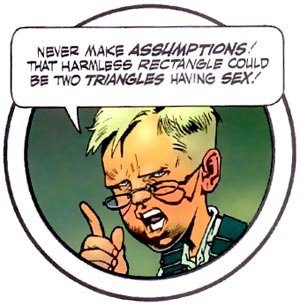... Graphic Novel back-cover blurbs?
It seems like they're often written by people who might have heard a few things about the books from a friend who flipped through a copy once. Here are some examples from a couple books I liked (mostly for the art, granted), and an example of the right way to do it.
From Neil Gaiman and Dave McKean's Mr. Punch:
In his grandfather's failing seaside arcade, a young boy encounters a mysterious Punch and Judy Man with a dark past, and a woman who makes her living playing a mermaid.
Well, he does encounter those people, though I don't know how mysterious the Punch and Judy Man was, nor whether he had a dark past (maybe I slept through those pages).
As their lives intertwine and their stories unfold, the boy is forced to confront family secrets, strange puppets and a nightmarish world of violence and betrayal, in a fable of childhood innocence and adult pain.
Do their lives really intertwine? The boy observes their lives and their stories, and he's certainly affected by them, but did he really have that much involvement with or effect on any of the other characters? I'd say my life is more intertwined with my local reference librarian than the boy's was with them. And does he even confront family secrets, let alone be forced to do so? At least there are actually strange puppets, violence, and betrayal.
Then there's Jon J Muth's Swamp Thing: Roots:
One tree, whose twisted roots snare a cold evil that coils itself around a small town...
Snare a cold evil? Check. Coils itself around a small town? Not in the book I read, unless the town was so small it only had a population of 12-15.
One woman who's fleeing with her children from an abusive husband...
Or more accurately, a woman who has fled with her children from an abusive husband. '[Is] fleeing' implies pursuit.
And one man, seeking salvation, moves beyond flesh and blood and emerges from the murky depths of the Wabash River as...the Swamp Thing?
This compelling story of small-town terror and one Earth elementals quest for deliverance is written and painted by Eisner Award-winner Jon J Muth.
Okay, that part is true. The guy (with the initials A.H.) turns into Swamp Thing in the book called Swamp Thing. He damn well better.
Finally, look at the blurb from Howard Cruse's Stuck Rubber Baby:
Art and story combine powerfully in this lyrical tale of a young man caught in the maelstrom of the civil rights movement and the entrenched homophobia of small-town America. Toland Polk, the son of an uneducated white carpenter, has grown up in the Southern town of Clayfield. It is the 1960s, a time of passionate beliefs and violent emotions, and Clayfield's citizens are divided in the fight over segregation. As Toland fights on the side of the civil rights activists, he slowly begins to realize that he also has a more personal battle—to accept that he is gay.
That whole thing accurately describes the book. It's almost like the person who wrote that actually read it.
But looking at the description on Amazon, I saw this line:
As Toland fights on the side of the civil rights activists, he slowly begins to realize and try to deny that he is gay.
Well, no. That's not what happens. He already realized he was gay, and he was trying not to be. The other description is the right one.
Is it really that hard to describe the plot—not the story or theme, just the plot—of a book accurately? Hundreds of bloggers manage it every week, somehow. It doesn't really seem to be open to that much interpretation in most cases.

|